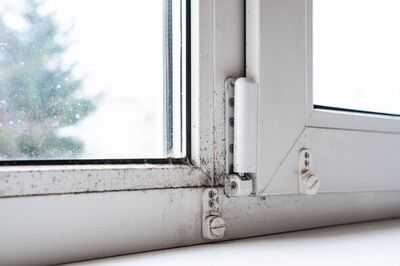
Now the weather is turning cold and wet, you're likely to wake up sooner or later to a layer of condensation dripping down your windows. Unfortunately, such damp conditions can quickly lead to mould.
The unsightly black scourge can start to plague homes at this time of the year thanks to the frequent rain showers, frosty mornings and generally chilly conditions which together provide the ideal environment for mould to thrive. Condensation forms when warm, moist air in your home meets the cold surface of your windows, causing droplets of water to form as they cool. This sitting water can cause mould and mildew to build-up around your window. While the go-to solution to tackle condensation may be to throw open your windows to allow moist, humid air to escape and to ventilate rooms, helping fresh air to circulate, experts say there is another method that works much better.
Using a dehumidifier in your home is considered a more effective and efficient way to combat mould than opening windows as it helps to better control moisture levels inside rooms.
Dehumidifiers work by removing moisture from the air, which then lowers the humidity and makes it more difficult for mould to thrive. By comparison, opening windows can often introduce even more moisture from outside and so the ventilation is more inconsistent.
Plus, you also have to deal with the cost of having to reheat the room where you have allowed fresh, cold air from outside to enter, which can quickly result in bigger energy bills.
An expert from Meaco explains: "A dehumidifier is a superb way to manage relative humidity in your home and reduce condensation. Plus, a dehumidifier is the only way you'll remove moisture.
"Condensation occurs because of temperature and relative humidity. You are unlikely to control the temperature of your windows, but you can manage relative humidity with a dehumidifier. Making a dehumidifier an incredibly effective choice to prevent condensation.
"Running a dehumidifier does of course have a cost to it. There is an initial price of the unit, and then there's the electricity cost to run it. But there is an important difference between the cost of running a dehumidifier and the cost of heating air."
The expert adds: "Opening the windows does work but I am not a fan because of two reasons. One, it makes people feel uncomfortable. Secondly, there's a huge hidden cost of reheating the fresh air coming in from outside. With energy bills skyrocketing it seems a real waste of money to keep on throwing the energy outside."
Experts say dehumidifiers can be used in combination with opening windows to help prevent mould growth as this will ensure good ventilation throughout your home.
It's a good strategy to open your windows after spells of rain, after a shower or cooking to allow air to circulate and release any moisture that has entered your home, then use a dehumidifier to further reduce humidity levels.
Hardware retailer Screwfix adds: "Dehumidifiers vastly improve damp and condensation problems in a home because they reduce moisture levels.
"They're most useful in rooms where there's a lot of humidity. For example, a kitchen or bathroom, a room where clothes are dried, or in a bedroom where condensation builds up from the heat caused by breathing."
You may also like

SNL's 'Weekend Update' gets dark as Colin Jost mocks Trump's Halloween clip

Fake Gaming Links Can Drain Your Bank Account in One Click — Government Issues Urgent Warning for Parents

Digital Life Certificate campaign 4.0 aims to reach 2 crore pensioners

5 Hidden iPhone Features That Can Completely Change How You Use Your Phone — The Secret Lies in the Settings!

Asda, Lidl and Poundland among the 167 UK store openings before 2026






